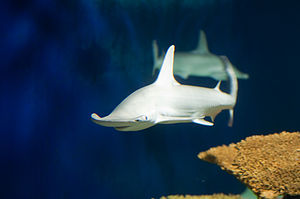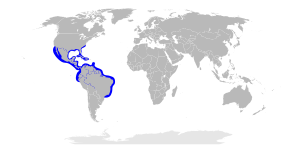Shovel-nosed hammerhead shark
| Shovel-nosed hammerhead shark | ||||||||||||
|---|---|---|---|---|---|---|---|---|---|---|---|---|

Shovel-nosed hammerhead shark ( Sphyrna tiburo ) |
||||||||||||
| Systematics | ||||||||||||
|
||||||||||||
| Scientific name | ||||||||||||
| Sphyrna tiburo | ||||||||||||
| ( Linnaeus , 1758) |
The shovel-nosed hammerhead shark ( Sphyrna tiburo ), also known as the little hammerhead shark , belongs to the family of hammerhead sharks (Sphyrnidae). The Greek word Sphyrna for hammer describes the shape of the head.
anatomy
The average size is about 100 centimeters, but there are also larger specimens.
distribution
The sharks live in the Western Hemisphere at water temperatures above 21 ° C. They can be found from New England (more rarely) to the Gulf of Mexico and Brazil and from southern California to Ecuador . In summer they tend to be near the coast of North / South Carolina and Georgia , in spring, summer and autumn near Florida and the Gulf of Mexico, while in winter they are more likely to be found at the equator in warmer waters.
behavior
The paddle-nosed hammerhead shark is an active tropical shark that can be found in small groups of 5 to 15 animals, with schools of hundreds and even thousands of sharks reported. They swim continuously, covering long distances each day to follow changes in water temperatures. The sharks have to keep moving in order to take in oxygen through their gills . They sink when they are not moving, as hammerhead sharks are specifically among the heaviest fish. Because of their small size, they are generally considered harmless.
nutrition
The shovel-nose hammerhead feeds on crabs, small fish, mollusks and seaweed . They are the only previously known sharks that are omnivorous and able to digest plant matter. Seaweed can make up more than 60% of the food consumed. The rear teeth of the shovel-nose hammerhead are broad and almost molar-like. This means that the seaweed can be shredded in the mouth. Among the digestive enzymes are starch-degrading amylases and glucosidases , with which the fiber-rich food in the intestine can be broken down.
Reproduction
The paddle-nosed hammerhead shark is viviparous . The young talent in the uterus of the mother animal approach and feeds to birth a yolk sac - placenta . The young are born in late summer to early autumn with a size of 30 to 33 centimeters. The shovel-nosed hammerheads reach sexual maturity at a size of about 75 centimeters.
In Henry Doorly Zoo of Omaha , Nebraska , came in 2001 proved a healthy female young is born without the mother had ever mated. After genetic analyzes of the genetic makeup of mother and daughter, it was also possible to rule out artificial insemination that was carried out secretly, so that this observation is the first evidence of parthenogenesis in sharks. The authors of the genetic analysis concluded that hammerheads are able to switch from normal sexual reproduction to asexual reproduction when there is a “lack of men”.
swell
- ↑ Samantha C. Leigh, Yannis P. Papastamatiou, Donovan P. German: Seagrass digestion by a notorious 'carnivore.' Proceedings of the Royal Society , September 2018. DOI: 10.1098 / rspb.2018.1583
- ↑ Demian D. Chapman et al. a .: Virgin birth in a hammerhead shark . In: Biology Letters . tape 3 , no. 4 , 2007, p. 425-427 , doi : 10.1098 / rsbl.2007.0189 , PMC 2390672 (free full text).
- ↑ Hammerheads can do single tricks. In: Spiegel Online. May 23, 2007.
Web links
- Sphyrna tiburo on Fishbase.org (English)
- Sphyrna tiburo. In: Shark Foundation.
- Sphyrna tiburo inthe IUCN Red List of Threatened Species 2013.1. Posted by: Cortés, E., 2005. Retrieved October 12, 2013.

